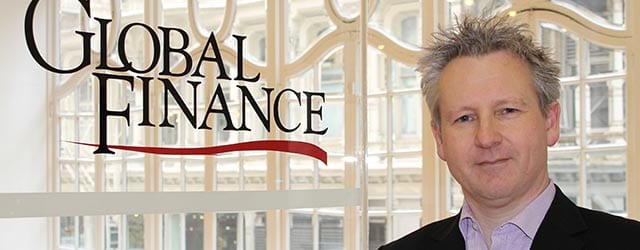Peter Hayes, global head of invest-ment research for Prudential Real Estate Investors, joined Global Finance editors in New York to talk about which property markets look hot in 2016—and which look too hot.

Global Finance: Has the US real estate market peaked, and is Europe catching up?
Peter Hayes: The US has been leading a good recovery story, and we expect the market will continue to perform relatively strongly for the next two to four years. Rents have picked up, especially in the gateway cities. The big thing in the US is that you haven’t had a huge amount of development activity. Still, it’s a market where we think you’ll need to be a bit more selective going forward. Europe’s recovery is lagging the US by a couple of years. Investors have been nervous about buying into the Europe story, but in places like Paris and London’s West End, strong rental growth has produced strong returns. Grocery retail has also done very well in Europe’s urban centers. And places like Spain, Italy and Ireland are bringing up the back of the recovery story, so they’re doing well at the moment.
GF: What about the emerging markets?
Hayes: Emerging markets are all about growing cities. The problem is, you have a lot of supply, and when demand slows down, you have supply risk. Investors are worried about oversupply in places like Kuala Lumpur, Hanoi and also Beijing and São Paulo. But we think it’s a good time to buy in markets like Brazil and China, where values have been falling and you can capture the recovery. We’ll have a better idea about the turning point in six months’ time.
GF: Do you see a bubble forming?
Hayes: Investors have been saying property is too expensive for five years. Historically, yields have been at 5%, 6% and higher. Now they’re at 2.5% or 3%. But we’re in a world of quantitative easing, where central banks wanted investors to drive asset prices up, improve growth and get unemployment down. And they’ve done that. Now we’ve got a disconnect between fundamentals and pricing, in fixed income, in equities and in real estate. But the reason we’re not worried about a bubble is that there isn’t a huge amount of debt in real estate, as there was in 20042006. Debt levels around the world are relatively low, which helps reduce volatility around value losses. Still, investors are nervous. The last time we were here, it didn’t end well.
GF: So how do you build the investment case for real estate to corporates?
Hayes: Corporates have typically not been big players in the market. Their share is growing, but it’s not off a big base. If they’re interested in real estate, they’ll typically go through a fund, or a fund of funds, rather than direct investing—though when markets are doing well, they can release a lot of capital with a sale-leaseback. But for institutional investors, pension funds and insurance companies, which have a liability-driven investing model—where they have to match assets to liabilities—real estate is a long-term income play.
GF: What kinds of returns are they getting?
Hayes: You can think of real estate as a hybrid investment. It offers you a bond-like return, because you’re getting income from an asset, so it has a fixed-income feel to it, but it has an equity component as well. There’s growing interest in what real estate has to offer. Investors see it as an alternative, but it’s a long game. I can get a 7% return, fixed, for the next 20 years. What can I get on a 20-year bond? Now, if you go back 15 years, investors were looking at 8% and 9% returns—without any leverage—when they bought a prime, Grade A office building. So actually return requirements have been declining around the world. But interest rates have fallen significantly from where they were 15 years ago, so the return premium for real estate is still around 4% over bond yields.



